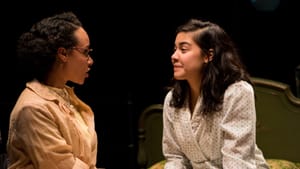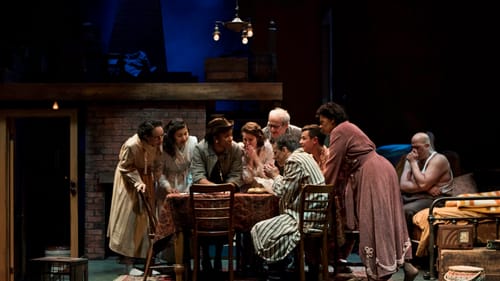Stay in the Loop
BSR publishes on a weekly schedule, with an email newsletter every Wednesday and Thursday morning. There’s no paywall, and subscribing is always free.
Notes for our time, and for all time
People's Light presents Frances Goodrich and Albert Hackett's 'The Diary of Anne Frank'

It's never the wrong time to see The Diary of Anne Frank, especially in a well-acted, smartly designed production like People's Light & Theatre Company's current revival. But some times are better than others.
In these days after the Parkland, Florida, school shooting and the protests and political action it has provoked, witnessing a teenager answer Nazi Germany's systematic extermination of Europe's Jews with wit, insight, and even hope inspires the same in us. Teenagers have stood up against violence and complacency before, and they will again.
A fresh telling
Wendy Kesselman's 1997 adaptation of the 1955 play by Frances Goodrich and Albert Hackett included previously withheld sections of Anne Frank's diary written during her family's years hiding in secret rooms above an Amsterdam office building. Kesselman revised the play in 2016, but director David Bradley's production has a freshness beyond this new script.
Scene changes are accompanied by Nazi songs, Hitler speeches, BBC broadcasts, and other authentic sound by Fabian Obispo, and projections on the set's imposing back wall provide dramatic visual information.
Set designer Luke Cantarella crafts the annex's claustrophobic conditions on People's Light's large Leonard C. Haas Stage. Each tiny room has its own level, allowing us to appreciate the cramped quarters where eight people hid from July 6, 1942, to August 4, 1944. Dennis Parichy's lighting captures the dimness of their isolation, though a sliver of blue sky upstage reminds us of the outside world.
Most importantly, the tedious business of staying alive unfolds in agonizing detail. As their protectors, Miep (Danielle Leneé) and Mr. Kraler (John Zak), explain, they cannot speak, cough, wear shoes, run water, or flush the toilet from 8 am to 6 pm, or the office workers below will detect their presence.
Along with Devon Painter's period costumes, the physical production achieves a visceral veracity that makes the conditions real, ideally framing the characters' experiences.
Brittany Annikka Liu's Anne, who narrates with diary readings and direct address, excels with childlike energy and ferocious honesty. She believably shows Anne's growth over the play's two-year span. First treating the situation as an adventure, when conditions worsen through hunger, fear, and boredom, her frustration gushes forth with equal determination.

Mark David Kaplan plays her beloved father Otto, and Deborah Green is fascinating as the mother Anne often resented. One cannot forget that all the characters are reflections of how Anne wrote them. Older sister Margot is a cypher despite Caroline Strang's efforts because Anne provided little record of her.
The boy who awakens Anne's romantic feelings, Peter (Tyler S. Elliott), is charmingly awkward. Melanye Finister and Brian Anthony Wilson play his squabbling parents, and Christopher Patrick Mullen makes an eccentric Mr. Dussel, the dentist they take in to save him from imminent capture. The believable drudgery of life in hiding extends through intermission, a striking contrast to the audience's blithe freedom a few feet away.
Their cramped existence reminds us that hell, as Jean Paul Sartre said, is other people. Moments of joy and tenderness occur, however: none lovelier than a meager Hanukkah celebration where Anne provides gifts for everyone.
The elephant in the room
"I wonder," Anne says, "if anyone will ever not think of me as Jewish?" People's Light's production complicates her question with colorblind casting. Several actors are clearly not Ashkenazi Jews, including the performers playing Anne, Margo, Miep, Peter van Daan, and his parents.
The casting represents a statement of universality: while the Holocaust was a specific event in history, these choices say, oppression and genocide can occur anywhere, to anyone, if fascism is allowed to flourish. Making such a bold gesture can backfire if it distracts us from the play, but The Diary of Anne Frank doesn't suffer from this choice, in my opinion.
The cast's compelling performances, the characters' extreme conditions, and the well-known historical facts combine to focus our attention on the characters' essences, not their physical features. The only time I pondered actor ethnicity was ruefully noting irony in the black adult van Daans' wishing they had escaped to America, where as nonwhites they would have also suffered discrimination. The moment soon passed.
Much more absorbing was the inevitable ending, played with more deliberate destruction and genuine terror than most other productions I've seen, accented by a crescendo of harsh lights and rumbling sound. Not only Anne's youthful exuberance and rebellion feel contemporary in The Diary of Anne Frank; the threat of official oppression feels familiar too.
To read Wendy Rosenfield's essay about this production, click here.
What, When, Where
The Diary of Anne Frank. By Frances Goodrich and Albert Hackett, adapted by Wendy Kesselman, David Bradley directed. Through March 31, 2018, at the People's Light & Theatre Company, 39 Conestoga Road, Malvern, Pennsylvania. (610) 644-3500 or peopleslight.org.
Sign up for our newsletter
All of the week's new articles, all in one place. Sign up for the free weekly BSR newsletters, and don't miss a conversation.

 Mark Cofta
Mark Cofta